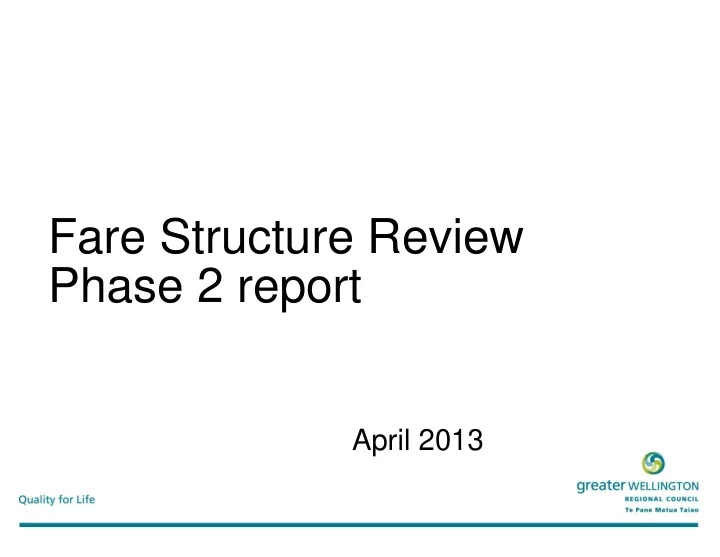

Fare Structure Review Phase 2 report April 2013
Outline of presentation • Objectives and assessment criteria • Current structure • Fare structure components – Zones vs Distance – Fare products – Fare concessions • Possible packages
Objective and criteria • Simple, easy to understand To develop a fare and use structure that is: • Encourage patronage – Equitable for those using growth the system • Affordability for users – Simple and easy to • Ease and cost of understand implementation and on- going administration – Reflects the policies of the Regional Transport Plan • Support efficient network design, operations and – Maximises patronage while asset utilisation achieving the necessary • Deliver sufficient revenue level of fare box recovery . • Economic efficiency
Current structure
Travel patterns bus and rail
Current fare per km
Structure options: • 5 zones • 7 zones • 8 zones – 7 zones with a Wellington inner city ‘CBD’ zone • Distance based • revenue neutral approach
Larger zones
Distance based fares
Summary of modelling • Short trips outside Wellington disadvantaged with both larger zones and distance based • Introducing a short-trip fare resolves issues in Wellington only • No compelling case to move away from concentric zones
Products • Currently have approximately 250 • 56 are the standard zonal fares • 70 commercial (airport flyer, cable car …) • Options: – Off peak fares – Fare caps vs passes – Concession groups
Current product discounts
Reference Group view Philosophy around products should be to: • Products should mode neutral • Reward desirable behaviours – Off peak travel – Multiple trips or frequent travel • Reduce the number of products – Easier to understand and use – Facilitates integrated ticketing
Bus users – trips per day No of times SV cards used per day by no of days a week travelled - Monday 4500 4000 3500 3000 No of cards used 2500 2000 1500 1000 500 0 1 2 3 4 5 OR MORE No of times card used per day Days per week travelled using PT 1 2 3 4 5
Future Products • Monthly and daily products replaced with daily and/or weekly caps • Existing integrated passes replaced with standard approach to transfers • Standardised approach to off peak fares, school passes, etc • Proposed new weekend family pass
People with a disability and beneficiaries • Options include – Do nothing – Phase out – Off peak concession for all users – Replace with standard concession with eligibility through Total Mobility or Invalids Benefit scheme • Advocacy for national approach
Tertiary students Without tertiary fare With tertiary fare – Canterbury – Bay of Plenty – Horizons – Gisborne – Auckland – Marlborough – Northland – Taranaki – Otago – Hawkes Bay – Southland – Tasman / Nelson – Waikato – Wellington
Tertiary students • Options include: – Do nothing – All day concession – Off peak concession for students or all users – Bulk purchase scheme • Preferred option – bulk purchase scheme or introduce off peak fare for all PT users
Developing potential fare packages Revenue impact Patronage impact � � Integrated fares / transfers � � Fare capping Child fare -$0.7m - 25% Peak/Off peak differential -$4.5m 3% 25% student concession, -$1.5m (all day) 7% / 5% (student) all day or off peak -$1m (off peak) 1% overall 50% student concession, -$4m (all day) 14% / 9% (student) all day or off peak -$3m (off peak) 1-2% overall $2m -3% (rail); Removal of rail monthly pass (if no transition) -1% overall Weekend family pass � -
Recommended package • Revenue neutral – Structure: refined concentric zone model – Concessions: children and young people 18 years and younger – Products: phase out little used or redundant products, and rail monthly discount after electronic ticketing introduced – Potential new products: weekend family pass • Integrated fares / transfers • Potential additions to revenue neutral package – Fare capping (in principle only and subject to further work) – Introduce a peak / off peak differential – Phase out existing concessions for beneficiaries and people with disabilities as off peak fare introduced
Next steps • Economic Wellbeing Committee – May 2013 • Decision around structure, some products and concessions, subject to consultation • Consultation through the draft Regional Public Transport Plan process • In principle decision around new and replacement products subject to further work on products through the Integrated fares and ticketing project
Questions
Recommend
More recommend